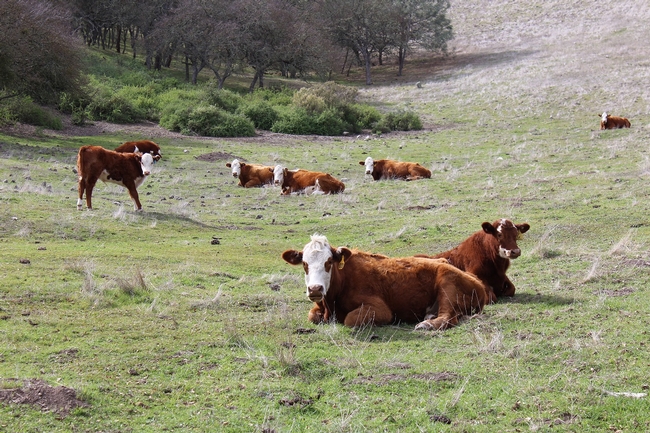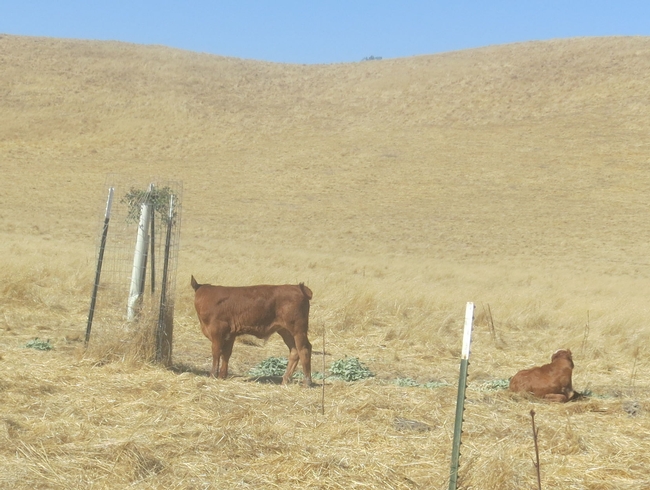By Devii Rao and Karminder Brown
The Schmidt Family Ranch and Peterson Land & Cattle Company has received the 2020 Excellence in Range Management Award from the California-Pacific Section of the Society for Range Management. The award recognized the family for maintaining outstanding ranch management and land stewardship practices across distances and generations. The awards ceremony was held virtually through Zoom on January 29th during the California Rangeland Conservation Coalition 2021 Summit. The award was co-presented to members of the Schmidt Family by Devii Rao, UC Cooperative Extension, and Karminder Brown, San Benito Working Landscapes Group.
The Schmidt cousins own three ranches in San Benito County, covering 6,800 acres: Bear Valley Ranch, Horse Valley Ranch, and the Peterson. Two of the three ranches are adjacent to Pinnacles National Park. The family has been in business on these properties since the 1880's, making the current owners 4th and 5th generation ranchers.
The Schmidt Family Ranch and Peterson Land & Cattle Company (PLCC) represent a complex family arrangement. All three ranches are owned by six Schmidt cousins and their families. This includes three members from the Jef Schmidt Family (Brian Schmidt, Kathy Spencer, and Crystal Henzi) and three members from the Stan Schmidt Family (Rick Schmidt, Janice Schmidt, and Greg Schmidt). All ranch decisions are made jointly by the six cousins and their families, even though most of the cousins live in Santa Clara or Monterey County. Only Kathy Spencer lives on the Bear Valley Ranch with her husband Joe, and Kathy's brother Brian Schmidt and his wife Tina recently moved back to San Benito County.
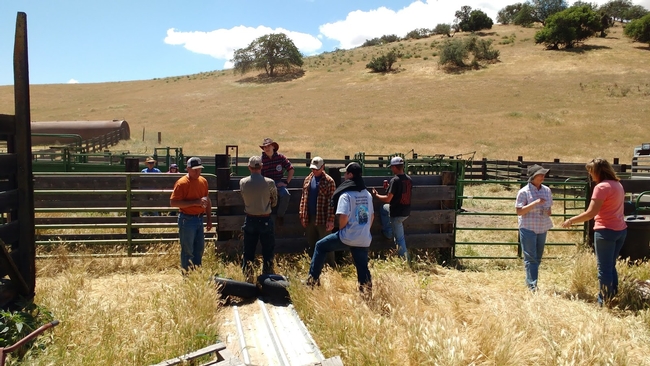
Separate from the ranch ownership, the three Jef Schmidt children and their spouses own and run the Peterson Land & Cattle Company. The PLCC rents the Bear Valley, Horse Valley and Peterson properties for their grassfed cow/calf operation. They do not use hormones or antibiotics, provide only approved mineral supplements and alfalfa, and treat their animals humanely. Through the 101 Livestock Auction Program, the PLCC is also certified natural, another marketing category, which indicates the cattle do not receive antibiotics. PLCC sub-leases part of the Horse Valley property to another family member, Scott Spencer, for both a stocker and cow/calf operation.
As with so many livestock operations in California, the Schmidt Ranch does not bring in enough revenue to support the entire family, so most family members work off the ranch. The Schmidt cousins' short-term goals include making enough from the ranch to pay for improvements to water infrastructure, fences, soil improvement, and weed management. Their long-term goals are to maintain the ranch as a whole, and not subdivided, so that future generations of the family can continue the ranching lifestyle, traditions, and land stewardship.
Commitment to Livestock Management and Rangeland Stewardship
The Schmidt cousins maintain meticulous health records of each animal and have DNA analysis done on their replacement heifers. These records help with making decisions related to replacement bull selection for breeding; identifying the best bloodlines for grassfed beef; identifying the best bulls for first calf heifers; and preventing breeding cows with bulls of the same bloodline. Health records are used to track the vaccines used, the health of the herd, and genetics of the individual members. Through direct-to-consumer marketing of their grassfed beef (e.g. newsletters and individual conversations), they educate the public about how grassfed beef is raised, and why their customers ought to care about how their meat is produced.
The Schmidt cousins have worked with the USDA Natural Resources Conservation Service (NRCS) since 1995. Through the Environmental Quality Incentives Program (EQIP) they have installed extensive livestock water and fencing projects to improve livestock distribution throughout the ranches, which improves soil quality, water quality, and habitat for aquatic organisms and native plants. The cousins have also participated in NRCS's Conservation Stewardship Program (CSP), which allowed them to implement additional conservation practices, including wildlife escape ramps, ranch planning, and native plant restoration. The family experimented with different available wildlife-friendly trough designs, finally developing their own wildlife ramps and installing them in all of their troughs. They provide additional water, through guzzlers, for doves, quail and deer. Through the CSP, the cousins wrote an annual grazing plan, and monitored vegetation twice a year from 2009-2014. They also installed several native plant restoration projects, including oaks and other native trees, shrubs, and grasses.
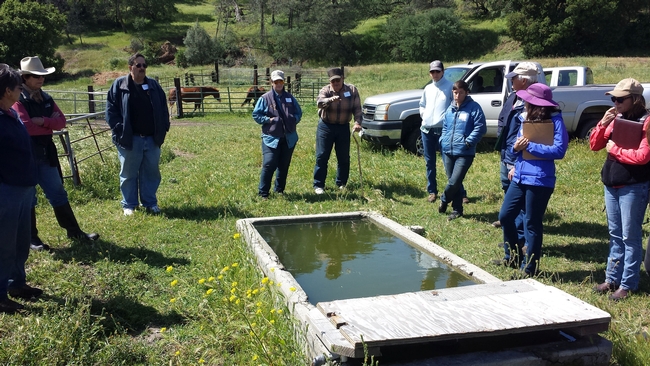
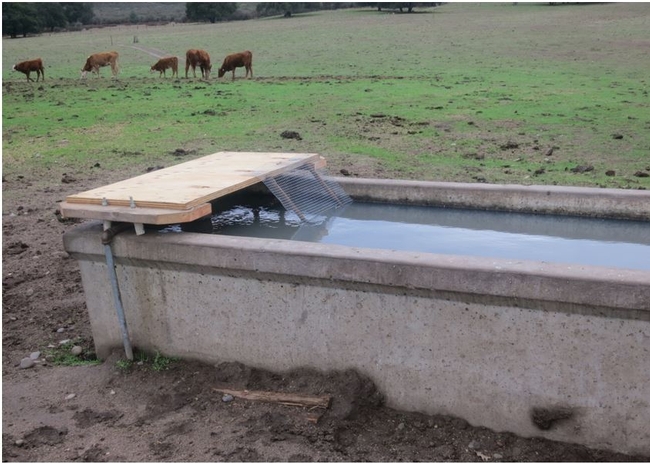
A Passion for Restoring Native Oaks
The cousins became interested in oak restoration because of a research project that the previous generation had participated in during the 1980's with NRCS and UC Davis. As part of that study, acorns were planted on the Bear Valley Ranch. During the 1990's, one of the cousins, Rick Schmidt, attended several conferences on oak restoration, which inspired the family to begin planting more oaks in the 2000's.
For the NRCS-CSP oak restoration project, most of the family collected and planted valley and live oak acorns, protecting them with tree shelters stabilized with t-posts. Rick's sister Janis Schmidt and his wife Stacey Swenson hand-watered the acorns from 2010-2013, through 3 years of severe drought. Acorns were planted (and replanted every year) in more than 137 tree shelters in three oak groves across two ranches. On one ranch, Scott Spencer installed fencing around both groves. To date, about 30 valley and live oaks have survived across the three groves. Janis and Stacey continue to plant and water acorns throughout the three ranches to this day.
The family also planted native grass plugs that they propagated themselves from seed they purchased. In other areas they planted native grasses directly from seed. As neighbors of Pinnacles National Park, the cousins asked the Park's botanist for recommendations of native grass species to plant. They also planted 128 native trees and shrubs which they purchased from a local nursery. Some of the species planted included big leaf maple, wild lilac, California fuchsia, toyon, sticky monkey flower, yarrow, buckeye, silverbush lupine, blue elderberry and black sage. These plantings will improve wildlife habitat, increase shade for cattle, and enhance the aesthetic value of the ranch. The Bear Valley restoration project is highly visible from state Highway 25, a road that many tourists drive and enjoy on their way to Pinnacles National Park.
At the award presentation Rick Schmidt shared the following words, “I'm honored to have us receive this award for something that I've been passionate about personally, and the rest of our family too, for a long time. Having grown up seeing the mortars and pestles and the acorns in Horse Valley, and a lot of the valley oaks disappearing, I wanted to restore the valley oaks and the riparian areas. Some of the trees are now 30 feet tall. Seeing that is a reward in itself, but getting this award is icing on the cake!”
Rick also emphasized that the cousins' spouses and extended family have contributed to the success of the ranch, “It's not only the owners and six cousins, but also our spouses, other family and friends that I want to thank for helping us to maintain and restore these ranches. Extended family, second cousins --we've all kind of grown up together and without their help, there's a lot of these projects that probably wouldn't have been completed. It's a true family effort, that goes beyond just us six cousins."
Keeping the Ranch Intact
The Schmidt cousins have also undertaken two critical steps to ensure the long-term conservation of their ranch: enroll in the Williamson Act and participate in estate planning. The Williamson Act reduces the tax rate on land that owners have agreed not to develop for the next ten years. The 10-year contract is renewed each year. Under the Williamson Act, the ranch will remain whole.
Estate planning is also critical for the conservation of rangelands. With careful planning a ranch can be passed down to the next generation, avoiding high estate taxes and subdivision and sale of parcels when the owners die. Kathy Spencer attended an estate planning presentation at the local Ranchers Seminar in 2014. Afterwards, she contacted an attorney to develop the estate planning documents, ensuring the ranch would stay intact and remain in the family through the next generation.
Contributions to Outside Organizations and Public Education
In addition to the work on their own ranch, the Schmidt cousins participate in various cattle and rangeland organizations. They are members of the Farm Bureau, National Cattlemen's Association, California Cattlemen's Association, San Benito County Cattlemen's Association, Beef Improvement Federation, and are Beef Quality Assurance certified.
While all of the Schmidt cousins have been involved with conservation organizations, Kathy Spencer has been particularly active. Since 2012 Kathy has been an integral participant in the San Benito Working Landscapes Group (SBWLG), a network of agencies, NGO's and ranchers who aim to ensure that working lands in San Benito County continue to thrive economically and ecologically. She has attended almost every SBWLG meeting during the past eight years to provide a rancher's perspective and to gather information about conservation opportunities to share with her neighbors in the local community.
Kathy and her husband Joe have hosted events, such as an Oak and Riparian Restoration Tour in 2016, and a local rancher's listening session with Congressman Jimmy Panetta in 2018. They have also invited SBWLG partners (non-ranchers) to participate in family brandings and other events which are normally family and community-only affairs, as a way to educate conservation partners about the realities and challenges of ranching in San Benito County.
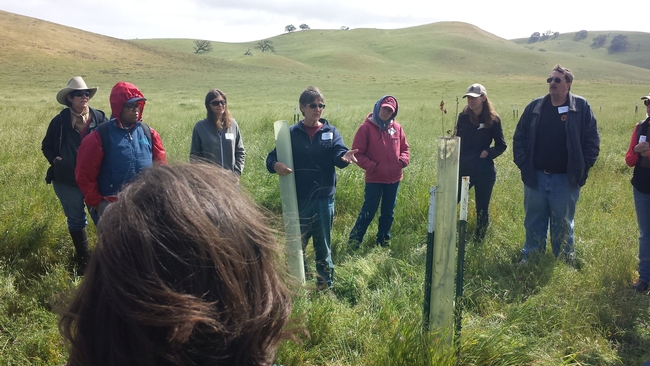
Since its inception in 2015, Kathy has regularly attended meetings of the Pajaro Compass Network, a regional network that supports conservation on farms and ranches in the Pajaro River Watershed. Her participation in these forums has helped to educate conservation professionals and agency representatives from sectors such as agriculture, public lands, water, and transportation about the challenges faced by family ranchers, as well as the benefits that ranches provide to watershed health.
UC Cooperative Extension (UCCE) has also benefited greatly from the knowledge that Kathy is willing to share. She has participated in multiple UC research projects that are locally relevant. As a speaker at a UCCE meeting about ranching technology she shared her own livestock tracking spreadsheets with attending ranchers to demonstrate how technology can help them better understand what is going on with each animal and the land.
In 2019, Kathy and her brother Brian, were speakers at a joint UCCE-SBWLG rancher workshop about prescribed burns. Together they provided a history and slides from the Range Improvement Association that their family was a part of in previous decades. Kathy and Joe also provided 125 gallons of water for a prescribed fire training on another San Benito ranch a few months later.
Kathy has also engaged with the Pinnacles Gateway Partners, a local organization that is trying to enhance recreational and economic development opportunities in the rural communities surrounding the National Park. And she has invited members of the Amah Mutsun Tribal Band to tour the Peterson and Horse Valley Ranches. The great grandparents of one of the tribal members used to own some of the property that is now part of the Peterson Ranch. Kathy was able to show them a canyon named after one of their relatives and several Native American artifacts and cultural sites.
Creative Solutions
One of the primary range management challenges today, is simply keeping the ranch in the family and ensuring it continues to be grazing land. The Schmidt cousins have worked tirelessly to keep the ranch intact. They have engaged in estate planning as a long-term solution, and are all active as a group to maintain the viability of the ranch. The family has had a hunting club on the Bear Valley Ranch since the 1950's, with some third-generation hunting club members now. Club members have built a nice little cabin for themselves on the ranch over the years. They pay an annual fee and have access to the ranch year-round. The hunting club allows the family to diversify income from the ranch. Club members hunt quail, doves, turkeys, pigs, and deer. There is also fishing in one of the stock ponds. Some members just use the ranch as a “get-away” from city life.
A serious challenge to management of the ranch is that since 1993 Kathy and Joe are the only owners living on site. All the other cousins have lived in Santa Clara, San Mateo, and Monterey counties, but as family members retire, they are gradually moving to the ranch or closer to it. Kathy and Joe oversee all three ranches year-round and are diligent about keeping all the cousins and their descendants engaged in activities at the ranches.
Kathy writes a weekly newsletter for her family, to keep them informed about what is happening at the ranch and in the community. Everyone in the family is invited to attend annual branding and pregnancy testing days, the 4th of July picnic, August family BBQ, and multiple workdays every year to maintain the ranch. During workdays, all family members help with corral repair, well maintenance, vegetation/tree debris removal, road maintenance, fence repair, maintenance of drainages, and maintenance of NRCS projects. All of these projects help to improve water quality, reduce erosion, improve livestock distribution, and enhance habitat for native plants and wildlife on 6,800 acres of beautiful Central Coast rangeland.
At the award presentation Kathy shared some insights into how the cousins came together to protect the ranch. “My father died in 1991 and we had this property literally dropped into our laps. At the same time, my Uncle Stan was deeding his property over to his kids. So the first thing that we cousins did was get together as a group and talked. That's really important -- to communicate.
We set our goal that we would not sell the ranch and keep it for the future, and it was something we all agreed on. We also agreed not to take too much on, not to go too fast, to see how things would work out. To begin with, my cousins had half the cattle and we had half. My cousins were younger and more involved in going to school and starting jobs, so that led to us three older siblings into buying them out and creating the Peterson Land and Cattle Company.
I just realized that we've been together 29 years as a family group, and over the years it takes time to build trust with one another. We do that a lot, by working together on these projects, like the oak planting, and we also do it by having fun. We just stop and take a break from the work to have fun -- in fact, we often say that if a couple of us get together, it's a party! We really enjoy ourselves, we enjoy each other, and that's how this complicated thing works.”
For more information about the Schmidt Family Ranch or Peterson Land & Cattle Company grassfed beef, contact Kathy Spencer at ksspencer48@gmail.com.
Author - San Benito County Director and Area Livestock and Natural Resources Advisor
